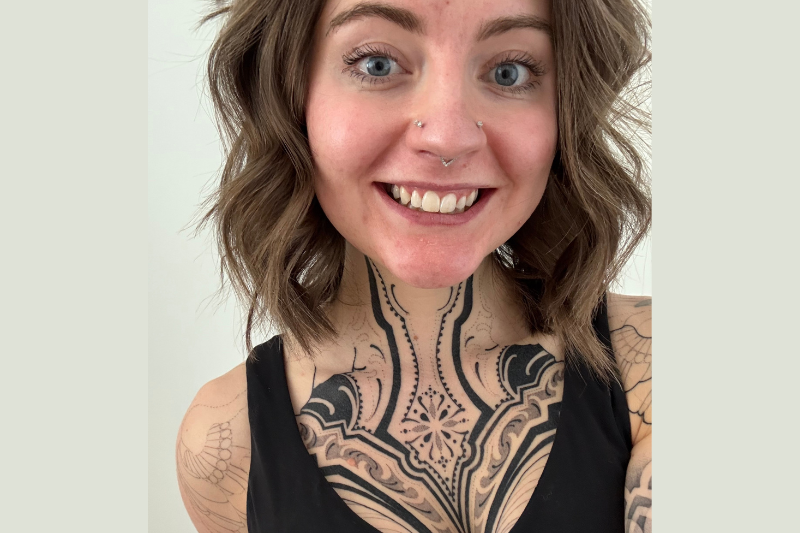When Alyssa Grocutt walks into a room, her tattoos often spark conversation — but not always the kind she’d prefer.
“People will ask, ‘Did it hurt?’ Well, yeah, there are needles going into my skin,” said Grocutt, a PhD candidate at the Smith School of Business at Queen’s University in Kingston, Ont. “Or, ‘How much did it cost?’ — which feels intrusive.”
Grocutt, who has extensively researched tattoos in workplace settings for her dissertation, noted that while society is gradually moving toward acceptance, stigma remains, particularly around what she terms “intimidating tattoos.”
“Tattoo content matters,” she said. Her research found that tattoos perceived as intimidating — such as a skull next to a knife — can lead to discrimination because the wearer is seen as riskier. Interestingly, though, these same tattoos also cause observers to view the individual as more artistic, reducing discrimination in other contexts.
“The key takeaway is that perceptions depend largely on the observer and the stereotypes elicited by the tattoo,” said Grocutt. “How can we promote positive stereotypes like artistic expression, rather than negative ones?”
Legal landscape and tattoos
From a legal standpoint, tattoos and other body modifications are generally not protected grounds under human rights legislation in Canada, according to Lai-King Hum, employment lawyer and founder of Hum Law Firm.
“An employer would not be in breach of any specific laws by refusing to hire someone because of tattoos,” said Hum. However, she noted that there are exceptions, particularly when tattoos reflect religious or cultural significance. “Refusing to hire someone bearing a tattoo indicating a racial or religious affiliation could lead to a legitimate discrimination claim.”
Hum highlighted cases such as Ottawa Hospital v. Canadian Union of Public Employees, Local 4000, where an arbitrator found a dress code requiring employees to cover tattoos was unenforceable. Hum pointed out a comment from the arbitrator who noted that the patient was “not being ‘forced’ to accept tattoos and piercings. The patient is merely receiving care from workers who reflect the diversity that one would expect in a big city hospital. It is not patients who are being ‘forced,’ but rather employees who are being told to suppress aspects of their identity that are important to them.”
Similarly, a Quebec Superior Court ruling in 2009 struck down a policy requiring daycare workers to conceal tattoos, deeming it an infringement on freedom of expression and privacy, she said.
Workplace authenticity and performance
Beyond legality and bias, Grocutt emphasizes another crucial point: authenticity. Employees allowed to express themselves authentically — including through visible tattoos — report improved mental health and higher job performance.
“Allowing employees to show their tattoos enhances feelings of authenticity,” she said. “That benefits both employees and organizations.”
Better conversations about tattoos
Grocutt believes that how tattoos are discussed in the workplace matters — and that employers should be mindful of the tone and focus of those conversations.
“I like getting asked about tattoos,” she said. “But I think a lot of the time it’s not the questions that I would want to talk about.”
Instead of asking about pain, cost or meaning — which can feel intrusive or reductive — Grocutt suggests shifting the conversation toward the artistry and personal expression behind the ink.
“Focusing more on why someone chose a particular design or what drew them to a specific style of tattoo can be more meaningful,” she said. “It’s another way people express who they are, just like talking about weekend plans or music preferences.”
She encourages organizations to treat tattoos as a legitimate expression of identity and to approach conversations with curiosity and respect.
Employers risk missing out
Employers who maintain negative biases against tattoos could inadvertently exclude nearly a third of potential hires. According to a survey by the Logit Group cited by Hum, roughly one-third of Canadian adults have tattoos, with even higher rates among Millennials (43 per cent) and Gen X (51 per cent).
Excluding such a large portion of potential candidates could create significant challenges for HR professionals and recruiters.
“Visible but discrete tattoos no longer bear the same social stigma they used to,” said Hum. “An employer refusing to hire on that basis may face backlash about a lack of inclusivity, especially when large public facing corporations such as Disney have embraced discrete tattoos not on the face.”
Generational shift and workplace culture
While research is limited, Grocutt pointed to anecdotal evidence that younger hiring managers tend to disregard tattoos in their hiring decisions, viewing them as just another form of personal expression.
“Older hiring managers tend to be less likely to hire tattooed candidates compared to younger ones,” Grocutt said, citing one study. “But surprisingly, there isn’t much formal research on generational differences.”
Shifting perspectives
To overcome biases, Grocutt recommends employers increase representation of tattooed individuals in training materials and internal communications.
“Even just representation through training materials or infographics helps,” she said. “It might not change perceptions overnight, but it shows we’re all just humans.”
As workplaces evolve, both Grocutt and Hum stress that inclusivity around tattoos could be an increasingly important factor in attracting and retaining talent.
“Tattoos are often an aspect of authenticity,” Grocutt concluded. “Embracing them is good for employees and good for business.”





